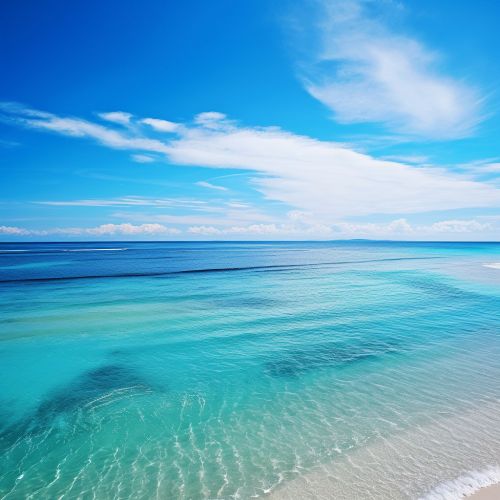Indian Ocean
Geography
The Indian Ocean is the third largest of the world's oceanic divisions, covering approximately 20% of the water on the Earth's surface. It is bounded by Asia to the north, Africa to the west, and Australia to the east. To the south it is bounded by the Southern Ocean or Antarctica, depending on the definition in use.


Physical Characteristics
The Indian Ocean's average depth is 3,890 meters (12,760 feet), and its deepest point is the Diamantina Trench, near the coast of western Australia, which reaches 8,047 meters (26,401 feet). The ocean's volume is estimated to be 292,131,000 cubic kilometers (70,086,000 cubic miles).
Hydrology
The Indian Ocean is known for its warm water currents. The Agulhas Current, one of the strongest currents in the world, flows along the east coast of Africa, while the Leeuwin Current flows along the west coast of Australia.
Climate
The climate of the Indian Ocean varies greatly, from tropical waters in the north to subantarctic waters in the south. The ocean's climate can significantly influence the weather patterns in the surrounding continents, particularly through the Indian Ocean Dipole and the El Niño-Southern Oscillation phenomena.
Marine Life
The Indian Ocean is home to a diverse range of marine life. Notable species include the dugong, a large marine mammal, and the coelacanth, a rare order of fish thought to have been extinct. The ocean also supports a variety of commercially important fish species, such as tuna and shrimp.
Human Interaction
The Indian Ocean has been a zone of human interactions throughout human history. Early maritime history in the Indian Ocean was marked by the influence of the Indus Valley Civilization and the Maurya Empire in India. In the medieval period, Islamic traders dominated maritime routes across the Indian Ocean, while the Portuguese, the Dutch, and the British later established colonial possessions on various islands and coastal areas.
Economy
The Indian Ocean provides major sea routes connecting the Middle East, Africa, and East Asia with Europe and the Americas. It carries a particularly heavy traffic of petroleum and petroleum products from the oil fields of the Persian Gulf and Indonesia. Large reserves of hydrocarbons are being tapped in the offshore areas of Saudi Arabia, Iran, India, and Western Australia.
Environmental Concerns
Environmental issues in the Indian Ocean include overfishing, especially of sharks, and increasing ocean temperatures and ocean acidification due to global warming. The ocean's diverse marine ecosystems are threatened by the spread of invasive species, particularly the aggressive lionfish.
